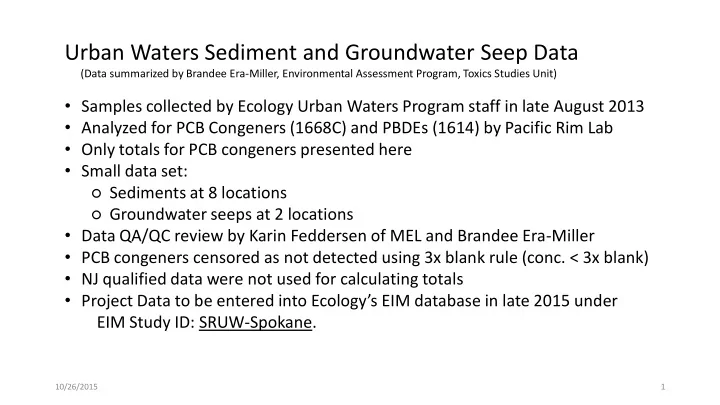

Urban Waters Sediment and Groundwater Seep Data (Data summarized by Brandee Era-Miller, Environmental Assessment Program, Toxics Studies Unit) • Samples collected by Ecology Urban Waters Program staff in late August 2013 • Analyzed for PCB Congeners (1668C) and PBDEs (1614) by Pacific Rim Lab • Only totals for PCB congeners presented here • Small data set: ○ Sediments at 8 locations ○ Groundwater seeps at 2 locations • Data QA/QC review by Karin Feddersen of MEL and Brandee Era-Miller • PCB congeners censored as not detected using 3x blank rule (conc. < 3x blank) • NJ qualified data were not used for calculating totals • Project Data to be entered into Ecology’s EIM database in late 2015 under EIM Study ID: SRUW-Spokane. 10/26/2015 1
10/26/2015 2
Sediment - PCBs Normalized to Organic Carbon 120 7000 100 6000 Total PCB ug/Kg OC 80 5000 Total PCB s ug/Kg 4000 60 3000 40 2000 20 1000 0 0 Total congeners Total Aroclors WA State Sediment Management Standards Normalizing PCBs to organic carbon shows for Freshwater Sediments that the pattern of higher PCBs at PostTerm2 Sediment Cleanup Objective = is real. Normalizing PCBs to percent fines 110 ug/Kg Total PCBs (Aroclors) (silt + clay) did not change this pattern either. 10/26/2015 3
Groundwater Seep - PCBs 100 90 • Spokane Tribal Standards = 1.3 pg/L 80 70 • WA State WQ Standards = 170 pg/L Total PCBs pg/L 60 • Approximate sampling system noise 50 From 2014 Synoptic Survey = 30 pg/L 40 30 20 10 0 DamGW-13 WaterGW-10 Trip Blank Monitoring Site 10/26/2015 4
Sediment - PBDEs BDE-99 BDE-47 BDE-209 2000 1200 5000 1800 4500 1000 1600 4000 1400 3500 800 ng/Kg dw 1200 3000 600 1000 2500 800 2000 400 600 1500 400 1000 200 200 500 0 0 0 • Concentrations of the most common/most often detected congeners: 47, 99 and 209 were highest at the PostTerm2 site. • Patterns did not change significantly with normalization to organic carbon or % fines. • No State Standards exist for PBDEs in surface water, sediment, or fish tissue though there is a fish tissue consumption advisory for PBDEs and PCBs in the Spokane River. • A closer look at congener patterns in this data set would be of value. For example, BDE-209 is much higher at PostTerm2 compared to other congeners at other sites, potentially indicating a different source at this location. 10/26/2015 5
Groundwater Seep - PBDEs 70 • Congeners 47, 99 and 209 were detected at 60 significant levels in the Laboratory Method Blank, so were censored as not detected 50 PBDE congeners (“U”) in the environmental samples. detected in the sample • Total PBDEs pg/L 40 Similar to the PCB results, DamGW-13 has a higher concentration of Total PBDEs relative to WaterGW-10 and the trip blank. 30 -015 • It would be a useful exercise to follow-up on -171 20 -183 congener patterns as different congeners -203 -196 were detected at each of the 2 Upriver Dam -206 -203 10 sampling locations and in the trip blank. -207 -207 -015 -208 -208 -017 -183 0 DamGW-13 WaterGW-10 Trip Blank Monitoring Site 10/26/2015 6
Recommend
More recommend